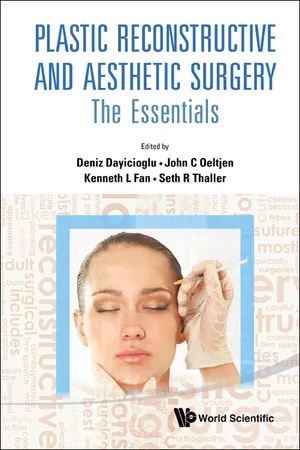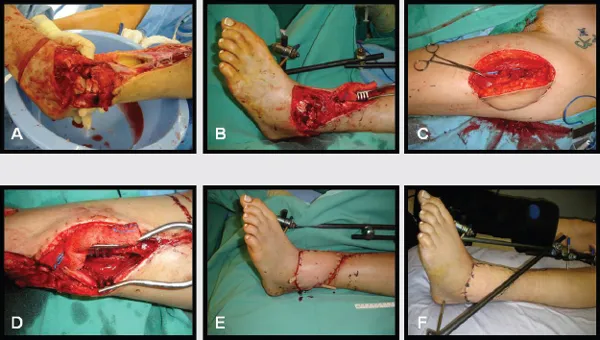
Plastic Reconstructive And Aesthetic Surgery: The Essentials
The Essentials (With DVD-ROM)
- 756 pages
- English
- ePUB (mobile friendly)
- Available on iOS & Android
Plastic Reconstructive And Aesthetic Surgery: The Essentials
The Essentials (With DVD-ROM)
About This Book
This is a concise but comprehensive textbook for plastic surgery residents reviewing for in-service and certifying examinations as well as practicing plastic surgeons preparing for Maintenance of Certification. The book is divided into chapters based on the 24 so-called common plastic surgical procedures. This will allow a discussion of the procedure prior to embarking on surgery and serve as a basis for the development of a basic fund of knowledge in the specialty of Plastic, Reconstructive, and Aesthetic Surgery. Contributors have been selected based on their clinical expertise and academic excellence.
Contents:
- Core Knowledge and General Principles:
- Wound Repair (Jason P Ulm and Kevin O Delaney)
- Grafts and Flaps (Jason P Ulm and Dennis K Schimpf)
- Anesthetic Implications in Cosmetic Surgery (Gian Paparcuri and Miguel Cobas)
- Lasers and Aesthetic Devices (Mark S Nestor and Matthew B Zarraga)
- Plastic Surgery Involving the Integument:
- Benign and Malignant Skin Lesions (Wrood M Kassira)
- Infantile Hemangioma (Karim W Sadik and Haaris S Mir)
- Burn Injury and Treatment (Jessica A Ching and C Wayne Cruse)
- Cleft Lip and Palate: Anatomy, Embryology, and Repair (Kenneth L Fan, Raja Mohan and Seth R Thaller)
- Essentials in Plastic Surgery Microtia Chapter (Kenneth L Fan, Raja Mohan and Seth R Thaller)
- Head and Neck Malignancy (David Nesky and Donald Weed)
- Principles in Facial Injury Management (Patrick Cole and Larry Hollier, Jr)
- Aesthetic Surgery of the Face: Face Lift (Erick Martell and Alan Matarasso)
- Eyelid, Cheek, Lip, Nasal, Scalp, Ear Reconstruction (Anuja K Antony, Victor J Hassid and Mimis N Cohen)
- Plastic Surgery of the Upper Extremity:
- Infectious and Inflammatory Disorders of the Upper Extremity (Joshua M Adkinson and Robert X Murphy, Jr)
- Compression Neuropathies in the Upper Extremity (Askari Morad)
- Benign and Malignant Tumors of the Upper Extremity (Sara Yegiyants, Yash Avasha and Zubin J Panthaki)
- Rheumatoid Arthritis of the Hand (Haaris S Mir and Stacy R Henderson)
- Congenital Hand Anomalies (Sara Yegiyants and Zubin J Panthaki)
- Upper Extremity Trauma (Deniz Dayicioglu and Derek Ulvila)
- Dupuytren's Disease (Sara Yegiyants and Zubin J Panthaki)
- Microsurgery: General Principles (Harvey W-M Chim and Christopher J Salgado)
- Plastic Surgery of the Lower Extremity:
- Lower Extremity Reconstruction (John R Barbour and Milton B Armstrong)
- Reduction Mammaplasty, Augmentation Mammaplasty, and Mastopexy (John C Oeltjen)
- Breast Reconstruction (John C Oeltjen)
- Aesthetic Body Contouring: Abdominoplasty (Steven Rueda and Seth R Thaller)
- Aesthetic Body Contouring: Abdominoplasty Body Contouring after Bariatric Surgery (Benjamin Lemelman, Paul G Cofnas and Seth R Thaller)
- Body Contouring via Suction Lipectomy (Michelle De Souza and Garry Martin II)
- Abdominal and Thoracic Reconstruction (Umbareen Mahmood and Deniz Dayicioglu)
- Pressure Ulcers (Jessica S Suber, Rajiv P Parikh and Deniz Dayicioglu)
- Vascular Anomalies (Harvey Chim and Arun K Gosain)
Readership: Practicing plastic surgeons preparing for Maintenance of Certification examinations, plastic surgery residents, general surgery and other specialty residents rotating through plastic surgery rotations; medical school students rotating through a plastic surgery rotation.
Frequently asked questions
Information

Table of contents
- Cover Page
- Title Page
- Copyright Page
- Dedication Page
- Contents
- Editors
- Contributors
- Foreword
- Preface
- Core Knowledge and General Principles
- Plastic Surgery Involving the Integument
- Plastic Surgery of the Upper Extremity
- Plastic Surgery of the Lower Extremity
- Index